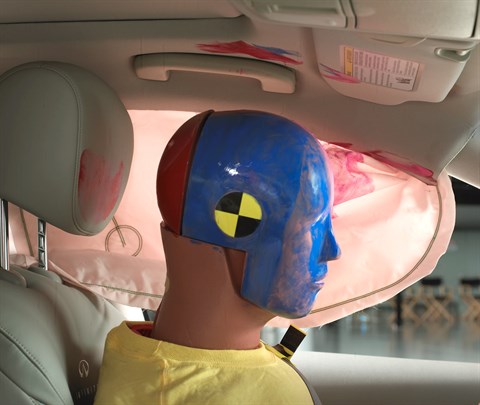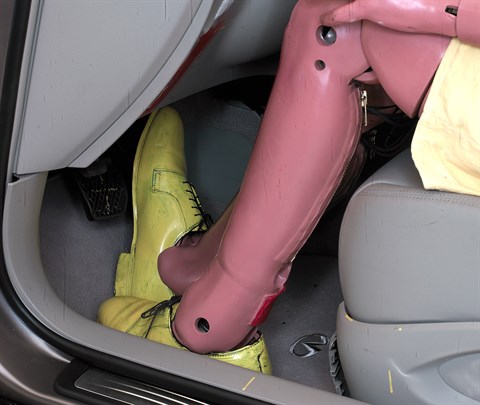Moderate overlap front: original test
Rating applies to 2014-17 models
Tested vehicle: 2008 Infiniti EX35 Journey 4-door 4wd
The Infiniti EX35 was introduced in the 2008 model year and renamed the EX37 in the 2013 model year because the engine size was increased. The EX was renamed the QX50 beginning with the 2014 model year.
| Evaluation criteria | Rating |
|---|---|
| Overall evaluation | |
| Structure and safety cage | |
| Driver injury measures | |
| Head/neck | |
| Chest | |
| Leg/foot, left | |
| Leg/foot, right | |
| Driver restraints and dummy kinematics | |

Action shot taken during the frontal offset crash test.

The dummy's position in relation to the steering wheel and instrument panel after the crash test indicates that the driver's survival space was maintained well.

Smeared greasepaint indicates where the dummy's head brushed the side airbag during rebound. The head also hit the roof, sunvisor, and grab handle before moving back against the head restraint.

Intrusion into the driver's space was minimal, and all leg and foot injury measures were low.
Measures of occupant compartment intrusion on driver side
| Evaluation criteria | Measurement |
|---|---|
| Test ID | CEF0726 |
| Footwell intrusion | |
| Footrest (cm) | 6 |
| Left (cm) | 7 |
| Center (cm) | 8 |
| Right (cm) | 7 |
| Brake pedal (cm) | 10 |
| Instrument panel rearward movement | |
| Left (cm) | 1 |
| Right (cm) | 1 |
| Steering column movement | |
| Upward (cm) | 5 |
| Rearward (cm) | 3 |
| A-pillar rearward movement (cm) | 0 |
Driver injury measures
| Evaluation criteria | Measurement |
|---|---|
| Test ID | CEF0726 |
| Head | |
| HIC-15 | 237 |
| Peak gs at hard contact | 38 |
| Neck | |
| Tension (kN) | 1.1 |
| Extension bending moment (Nm) | 21 |
| Maximum Nij | 0.26 |
| Chest maximum compression (mm) | 33 |
| Legs | |
| Femur force - left (kN) | 1.7 |
| Femur force - right (kN) | 1.5 |
| Knee displacement - left (mm) | 3 |
| Knee displacement - right (mm) | 10 |
| Maximum tibia index - left | 0.46 |
| Maximum tibia index - right | 0.73 |
| Tibia axial force - left (kN) | 1.8 |
| Tibia axial force - right (kN) | 2.1 |
| Foot acceleration (g) | |
| Left | 112 |
| Right | 59 |
Side: original test
Rating applies to 2016-17 models
Tested vehicle: 2016 Infiniti QX50 4-door 4wd
The Infiniti EX35 was introduced in the 2008 model year and renamed the EX37 in the 2013 model year. The vehicle was then renamed the QX50 beginning with the 2014 model year.
Starting with the 2016 model year, the QX50's wheelbase and overall length were increased primarily for more rear seat room. Side ratings are assigned by the Institute based on a test of a 2016 QX50 conducted by Nissan.
| Evaluation criteria | Rating |
|---|---|
| Overall evaluation | |
| Structure and safety cage | |
| Driver injury measures | |
| Head/neck | |
| Torso | |
| Pelvis/leg | |
| Driver head protection | |
| Rear passenger injury measures | |
| Head/neck | |
| Torso | |
| Pelvis/leg | |
| Rear passenger head protection | |
Measures of occupant compartment intrusion on driver side
| Test ID | VTS1604 |
|---|---|
| B-pillar to longitudinal centerline of driver's seat (cm) | -9.0 |
| Negative numbers indicate the amount by which the crush stopped short of the seat centerline. | |
Driver injury measures
| Evaluation criteria | Measurement |
|---|---|
| Test ID | VTS1604 |
| Head HIC-15 | 147 |
| Neck | |
| Tension (kN) | 1.4 |
| Compression (kN) | 0.4 |
| Shoulder | |
| Lateral deflection (mm) | 25 |
| Lateral force (kN) | 1.4 |
| Torso | |
| Maximum deflection (mm) | 22 |
| Average deflection (mm) | 18 |
| Maximum deflection rate (m/s) | 2.71 |
| Maximum viscous criterion (m/s) | 0.24 |
| Pelvis | |
| Iliac force (kN) | 1.0 |
| Acetabulum force (kN) | 1.6 |
| Combined force (kN) | 2.5 |
| Left femur | |
| L-M force (kN) | 0.6 |
| L-M moment (Nm) | 24 |
| A-P moment (Nm) | -127 |
Passenger injury measures
| Evaluation criteria | Measurement |
|---|---|
| Test ID | VTS1604 |
| Head HIC-15 | 72 |
| Neck | |
| Tension (kN) | 0.0 |
| Compression (kN) | 0.6 |
| Shoulder | |
| Lateral deflection (mm) | 26 |
| Lateral force (kN) | 1.3 |
| Torso | |
| Maximum deflection (mm) | 19 |
| Average deflection (mm) | 16 |
| Maximum deflection rate (m/s) | 2.57 |
| Maximum viscous criterion (m/s) | 0.18 |
| Pelvis | |
| Iliac force (kN) | 0.2 |
| Acetabulum force (kN) | 1.4 |
| Combined force (kN) | 1.4 |
| Left femur | |
| L-M force (kN) | 0.6 |
| L-M moment (Nm) | 18 |
| A-P moment (Nm) | -66 |
Head restraints & seats
Seat type: Power leather seats with manual adjustable lumbar AHR
| Overall evaluation | |
|---|---|
| Dynamic rating | |
| Seat/head restraint geometry |
| Seat type | Power leather seats with manual adjustable lumbar AHR |
|---|---|
| Geometry | |
| Backset (mm) | 26 |
| Distance below top of head (mm) | 38 |
| Seat design parameters | |
| Pass/fail | Pass |
| Max T1 acceleration (g) | 11.6 |
| Head contact time (ms) | 62 |
| Force rating | 1 |
| Neck forces | |
| Max neck shear force (N) | 58 |
| Max neck tension (N) | 494 |
About the head restraint & seat test
Currently, IIHS tests apply only to front seats.
Front crash prevention: vehicle-to-vehicle
Child seat anchors
Rating applies to 2016-17 models
| Evaluation criteria | Rating |
|---|---|
| Overall evaluation | |
| Vehicle trim | S |
| Seat type | leather |
This vehicle has 2 rear seating positions with complete child seat attachment (LATCH) hardware.
It has 1 additional seating position with a tether anchor only.
| Evaluation criteria | Rating |
|---|---|
| Overall evaluation | |
| Vehicle trim | S |
| Seat type | leather |
| Rating icon | Rating |
|---|---|
| G | Good |
| A | Acceptable |
| M | Marginal |
| P | Poor |
| Seating positions that rely on borrowed lower anchors or have only a tether anchor available are not rated. | |
thether anchor symbol | Tether anchor |
lower anchor symbol | Lower anchors |
| Lower anchor(s) can be borrowed from adjacent positions(s) | |
| No hardware available |
Details by seating position
| Position | Rating |
|---|---|
| 1 | |
| Tether anchor | |
| easy-to-find location | |
| no other hardware could be confused for anchor | |
| Lower anchors | |
| too deep in seat | |
| not too much force needed to attach | |
| difficult to maneuver around anchors | |
| 2 | |
| Tether anchor | |
| easy-to-find location | |
| no other hardware could be confused for anchor | |
| Lower anchors | |
| none available | |
| 3 | |
| Tether anchor | |
| easy-to-find location | |
| no other hardware could be confused for anchor | |
| Lower anchors | |
| too deep in seat | |
| too much force needed to attach | |
| difficult to maneuver around anchors |
Seat position 21
| Lower anchor A | |
|---|---|
| Open access rated | No |
| Depth (cm) | 4-6 |
| Force (lbs) | 36 |
| Clearance angle (degrees) | 52 |
| Lower anchor B | |
| Open access rated | No |
| Depth (cm) | 4-6 |
| Force (lbs) | 47 |
| Clearance angle (degrees) | 70 |
| Tether anchor | |
| Location | Middle seatback |
| Confusing hardware present | Yes |
| Has contrasting label within 3 inches of tether anchor |
Yes |
| Tether anchors can be accessed while seatback is properly positioned for use of LATCH |
Not measured |
Seat position 22
| Lower anchor A | |
|---|---|
| No lower latch for this seat position | |
| Lower anchor B | |
| No lower latch for this seat position | |
| Tether anchor | |
| Location | Middle seatback |
| Confusing hardware present | Yes |
| Has contrasting label within 3 inches of tether anchor |
Yes |
| Tether anchors can be accessed while seatback is properly positioned for use of LATCH |
Not measured |
Seat position 23
| Lower anchor A | |
|---|---|
| Open access rated | No |
| Depth (cm) | 4-6 |
| Force (lbs) | 38 |
| Clearance angle (degrees) | 61 |
| Lower anchor B | |
| Open access rated | No |
| Depth (cm) | 4-6 |
| Force (lbs) | 26 |
| Clearance angle (degrees) | 51 |
| Tether anchor | |
| Location | Middle seatback |
| Confusing hardware present | Yes |
| Has contrasting label within 3 inches of tether anchor |
Yes |
| Tether anchors can be accessed while seatback is properly positioned for use of LATCH |
Not measured |
